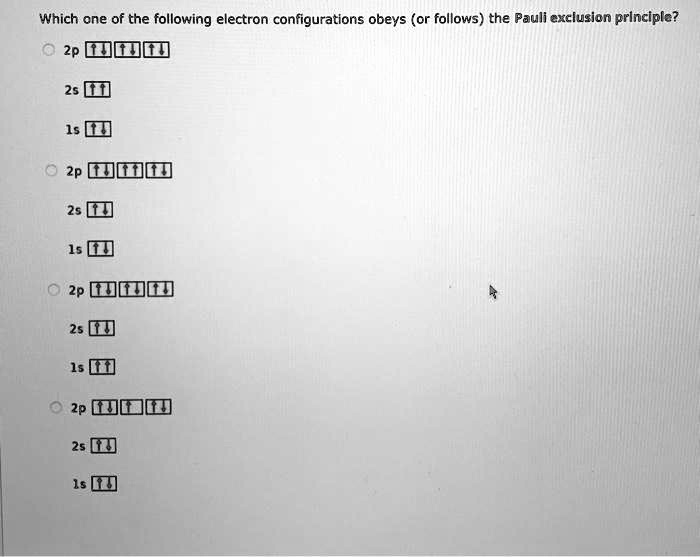Which one of the following electron configurations obeys (or follows) the Pauli exclusion principle? 2p [Q 25 WJ 15 W 2p [UL

The Correct Answer and Explanation is:
The configuration that obeys the Pauli exclusion principle is:
2p [↑↓] [↑↓] [↑] 2s [↑↓] 1s [↑↓]
This electron configuration is consistent with the Pauli exclusion principle, which states that no two electrons in an atom can share the same set of four quantum numbers. Each orbital can hold a maximum of two electrons, and these must have opposite spins—represented here by up (↑) and down (↓) arrows.
The 2p subshell consists of three orbitals. In this configuration, two of the orbitals contain two electrons each with opposite spins, and the third contains only one electron. This results in five electrons occupying the 2p subshell in a way that respects both the exclusion principle and Hund’s rule. Hund’s rule suggests that electrons fill degenerate orbitals singly first before pairing up, which is respected in this setup if the partially filled orbital received its electron last.
The 2s and 1s subshells each hold a pair of electrons with opposing spins, which is also correct. Since each of these orbitals contains only two electrons with opposite spins, they do not violate the exclusion principle.
In contrast, configurations where any single orbital contains two electrons with the same spin (such as ↑↑), or where the number of electrons exceeds the orbital capacity, would violate this principle. Additionally, filling all three 2p orbitals with six electrons (three pairs) can only occur in atoms with exactly six electrons in that subshell—such a scenario would be fine in isolation if each orbital has opposite spins, but in the given context, the configuration with five electrons arranged as [↑↓] [↑↓] [↑] is the only one that unambiguously satisfies the exclusion principle.
This configuration allows each electron to occupy a distinct quantum state, which lies at the heart of what Pauli’s principle requires.
